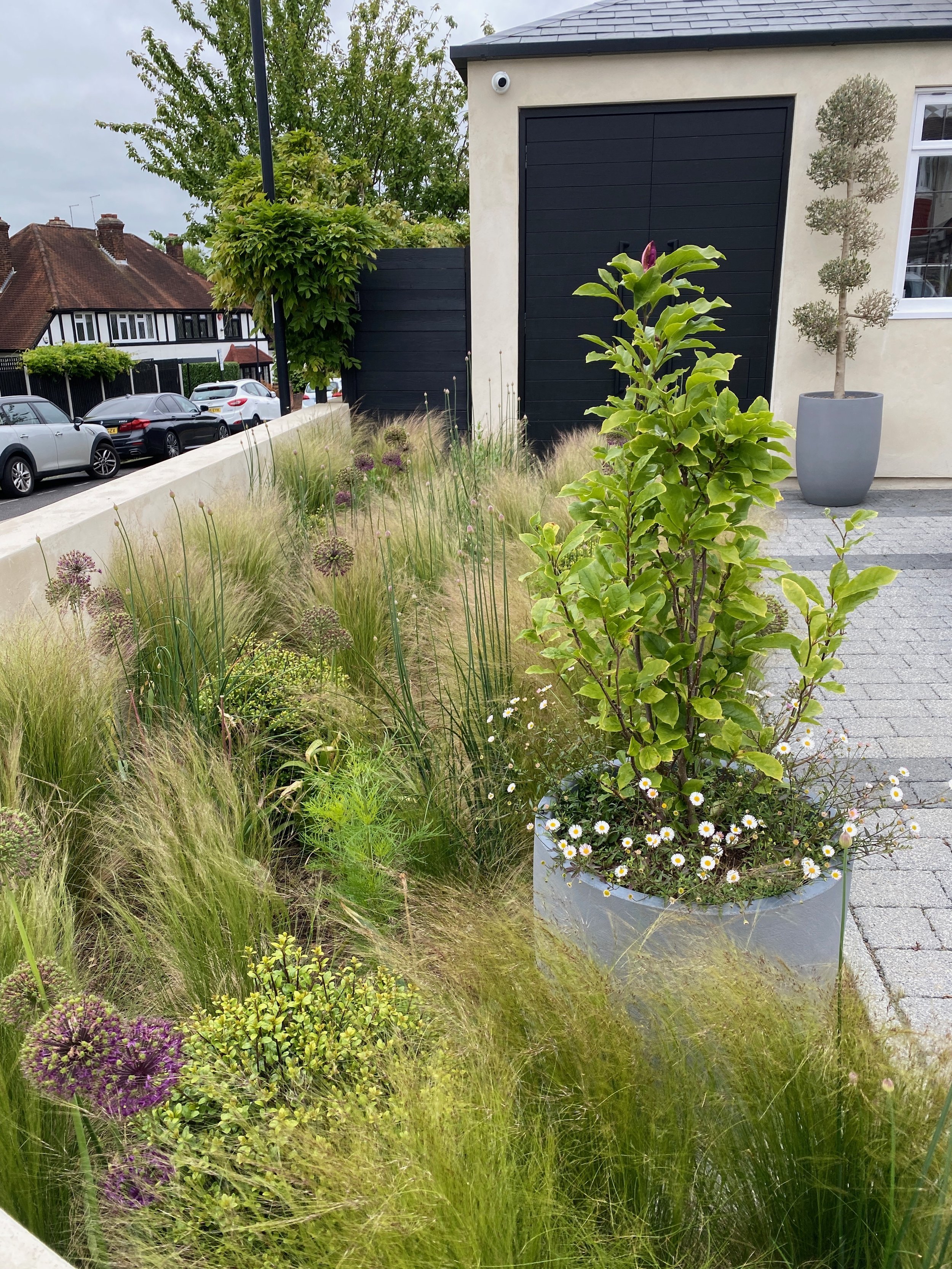Expert Guide to Designing Front Gardens
There are two big differences between designing and planning a front garden, as opposed to a back garden. These are that in most instances much of the garden will be given over to driveway and that generally a front garden is designed to be seen by your neighbours and travelled through by you when you return home (and therefore low maintenance tends to be a key consideration).
However that should never mean the front garden has to be boring. Indeed the kerb appeal of a house affects both its future saleability and, more importantly, how you feel every time you come home. As with all gardens planting is therefore key.
Planting Front Gardens
Generally a front garden should be relatively easy to maintain and so both plant choice and planting density are crucial to success. Denser planting suppresses weeds, maximises habitat for biodiversity, and also when done well extends the season of interest for your garden - be that in flowering or in the texture and form of the plants chosen. I also like to use planting as a sculptural indication (often in the form of topiary but not exclusively so) to put to one, or both, sides of the front door. This simple visual clue can really benefit grounding a home as I am always surprised at how many houses I visit where the location of the front door is not immediately obvious. Also the smaller the space the more plants I like to add…especially where there is just a courtyard with no driveway.
Practical Front Garden Considerations
Similar to maintenance considerations in plant choice, ongoing maintenance of your home is also crucial to factor into a front garden design - be that the ability to get to windows for cleaning, and gutters for clearing, or perhaps as simple as choosing a low maintenance surface for your driveway. Space to work and space for access are both fundamental to the success of a front garden design.
Often clients will also want structures in their front gardens - often in the shape of bin stores or cycle stores. As with all structures these should be sensitively designed or selected to blend with the house and the garden - and can often be hidden with climbing plants or perhaps a sedum green roof. However as with all garden construction it is crucial to understand the planning considerations around structures - as there are specific planning rules for the front garden. As at the time of writing (August 2023) outbuildings are not permitted in a front garden (froward of the ‘principle elevation’) - and so storage in the form of sheds or similar are not permitted.
Also to note, in front gardens there are quite specific planning rules around fencing. These are that if it is next to a road, or a footpath that is next to a road, a fence may not exceed one metre in height from ground level (except where there was an existing fence in which case the replacement may be installed at the same height or lower). In a large front garden it is strongly advised to talk to the planning authority about how far from the boundary with the highway is considered ‘next to’ if you wish to set a higher fence further back, for example.
Alternatively you may opt for a boundary hedge over a timber fence. This is a great option for privacy and also has an added benefit. Research has shown that hedging reduces noise, dust, and pollution and so will increase protection for you from the world outside your garden. Black carbon emitted by engines was shown to be reduced by up to 63% by having hedged boundaries. Further research has also highlighted that the best choice of plant for pollution reduction is Cotoneaster franchetii.
Drives and Front Gardens
However as I started with at the beginning, most front gardens will be given over in part or in the main to providing parking space. A driveway is always more costly to install than people expect and there is a wide choice of options - blocks, concrete, resin bound gravel, loose gravel, self binding gravel, tarmac, paving…the list goes on.
Personally I’m a fan of gravel - particularly with longer driveways as the crunch of loose gravel will highlight a vehicle or person approaching the house - but the choice should match the design, compliment the house, and fall within the budget available.
However it is vital to note that there are planning restrictions around your choice of replacement driveway surface (or new surface); again at the point of writing (August 2023) planning guidance states:
“You will not need planning permission if a new or replacement driveway of any size uses permeable (or porous) surfacing which allows water to drain through, such as gravel, permeable concrete block paving or porous asphalt, or if the rainwater is directed to a lawn or border to drain naturally. If the surface to be covered is more than five square metres planning permission will be needed for laying traditional, impermeable driveways that do not provide for the water to run to a permeable area.”
Permeable driveways are invariably the best option therefore (for the environment). Additionally it may be that you decide to add plants under where the cars will park to provide interest when they are away (although the vehicles do need to be moved fairly frequently to ensure the plants will receive sufficient light to survive and there need to be planting pockets of soil for their growth). Tough and low growing plants such a Thymes and Ajuga reptans (Bugle) are ideal although there is a wider range of options you could choose from.
The design of front gardens is a specific skill in itself and practical considerations need to be front and centre when planning a front garden to ensure it is fit for purpose - in terms of its functionality, its aesthetics, and its ongoing maintenance. However if you get all of these right it will ensure your home is always shown off in the best possible way.



